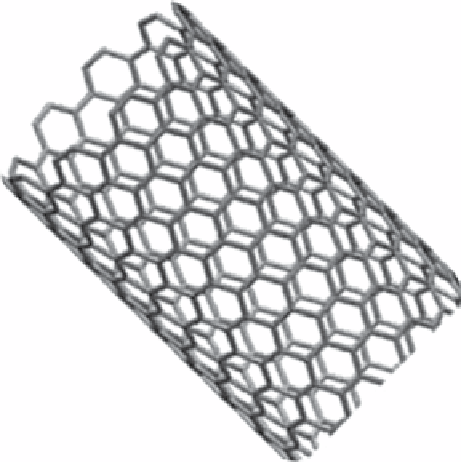Environmental Engineering Reference
In-Depth Information
(a)
(b)
figure 14.1
Models of (a) CNT, (b) C60.
CNMs, carbon nanotubes (CNTs) and fullerenes (FUls) receive the maximum attention because of their unique properties,
which includes thermal conductivity, stability, tensile strength, and their ability to act as conductors and semiconductors
depending on the chemical and physical treatments. Models of a CNT and C60 are shown in Figure 14.1. A general comparison
of their role as nanoadsorbents in environmental analysis on the basis of published data and their application in separation
sciences are shown in Figure 14.2.
14.2.1
Carbon nanotubes
CNTs, which were first noticed by Ijima in 1991, have been used for different purposes in the analytical sciences due to their
mechanical, electric, optical, and magnetic properties as well as their extremely large surface area. CNTs are hollow graphitic
material composed of one or multiple layers of graphene sheets (single-walled CNTs, sWNTs, and multiwalled CNTs,
MWNTs, respectively. The synthesis of CNTs can be carried out by means of three main techniques: chemical vapor deposi-
tion (Cvd), laser ablation (lA), and catalytic arc discharge (CAd). Cvd seems to be the most appropriate procedure for the
synthesis of CNTs for analytical applications due to the high purity and desirable tuning obtained at low temperature. However,
for all the synthesis methods, the presence of different undesired by-products (such as carbonaceous residues, amorphous
carbon, metal impurities) makes it necessary to purify CNTs. To purify synthesized nanotubes, different strategies including
chemical oxidation, physical separation, or combinations of both chemical and physical techniques have been employed.
Chemical oxidation is a purification system based on the fact that carbonaceous impurity residues are oxidized sooner than
CNTs. The main advantage is their ease, but it should be noted that the oxidation process affects the structure of the nanotube
introducing functional groups (hydroxyl, carbonyl, and carboxyl) and the defects in the side walls. Physical purification pro-
cedures are based on the different physical properties (such as size, ratio, weight, and electrical and magnetic characteristics)
between impurities and CNTs. Filtration, centrifugation, chromatography, and electrophoresis are the commonly employed
techniques. The disadvantages of these procedures are that (i) the elimination of certain impurities is inefficient; (ii) a high
dispersion of CNTs is required; and (iii) only a low quantity of CNT can be purified [6]. The effect of purification can be seen
in Figure 14.3.
The sorption sites on CNTs are on the wall and in the interstitial spaces between tubes. These sites are easily accessible for
both adsorption and rapid desorption. The impurities on CNTs reduce their availability because the sorbate has to diffuse
through these impurities to reach the CNTs. Moreover, the porous structure of impurities introduces mass transfer limitations,
slowing both adsorption and desorption. Understanding these characteristics is important for their application in separation
media. The excellent features of CNTs, along with their nano-scale features, make them ideal candidates for micro-scale
devices for gas- as well as liquid-phase analysis. In gas-phase analysis, one can employ a microconcentrator or a microsorbent
trap, which have been used in a variety of online chromatography and sensing applications. The purpose of such devices is usu-
ally to act as a fast preconcentrator or to modulate the concentration of a stream for real-time monitoring. They have been


